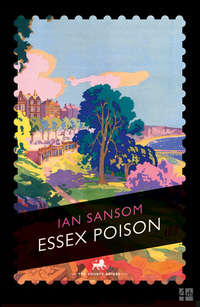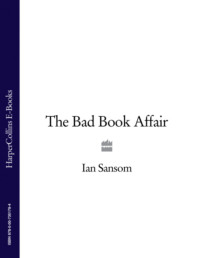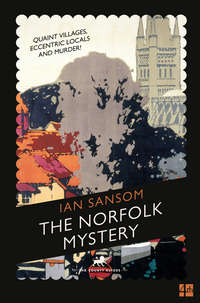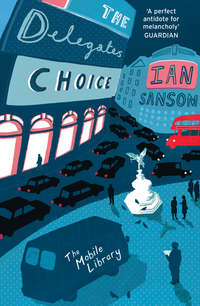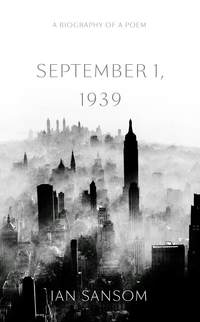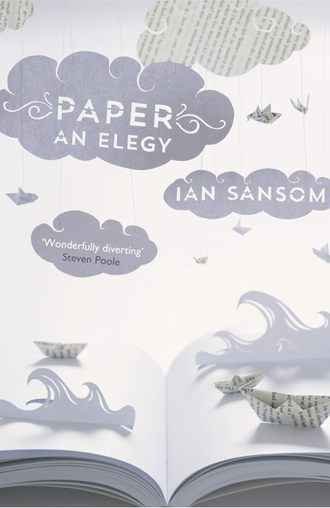
Полная версия
Paper: An Elegy



Praise
From the reviews of Paper: An Elegy:
‘Ian Sansom’s Paper: An Elegy has an intensity that might seem alarming if you didn’t share his obsession … Sansom’s scholarship is prodigious; his enthusiasm inexhaustible … He can make one laugh out loud by his placing of a single word (“Anyway”). He writes that when he dies, he wants to be buried in a paper coffin. And by the time you’ve finished reading this extraordinary book, so will you.’ Jane Shilling, Daily Telegraph
‘He settles on calling his book a “personally curated Paper Museum”, but few curators are so engaging and dynamic.’ Andrew Martin, Financial Times
‘His wonderfully diverting book … is not strictly a history of paper; rather, he invites us to explore it as we might wander around an eccentrically curated museum. One may also imagine it as a vast shoebox stuffed with fascinating facts jotted on a multi tude of scraps shored against paper’s ruin … splendidly dense with fact and thought.’ Steven Poole, Times Literary Supplement
For Nicholas and George, with thanks for Christmas lunch
The old book collector’s pulse was almost visible, throbbing in his wrist and temples. His voice became deeper as he held the book up to his eyes so he could read more clearly. His expression was radiant.
‘A magnificent book,’ confirmed Corso,
dragging on his cigarette.
‘It’s more than that. Feel the paper.’
ARTURO PÉREZ-REVERTE, The Club Dumas (1993)
CONTENTS
Cover
Title Page
Praise
Dedication
Epigraph
RESPECTING PAPER: An Introduction
1. A Miracle of Inscrutable Intricacy
2. In the Wood
3. Walking Papers
4. Victims to the BIBLIOMANIA!
5. Ornamenting the Façade of Hell
6. The Soul of Advertisement
7. Constructive Thinking
8. The Secret is the Paper
9. The Squiggle Game
10. A Wonderful Mental and Physical Therapy
11. Legitimationspapiere
12. Five Leaves Left
THE HOLLOW IN THE PAPER: Acknowledgements
TEARING THE BOOK INTO PIECES: A Bibliography
Text Permissions
About the Author
By the same Author
Copyright
About the Publisher
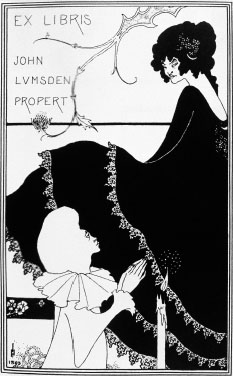
Bookplate by Aubrey Beardsley © The Bridgeman Art Library Ltd
RESPECTING PAPER An Introduction
First of all, respect your paper!
J.M.W. TURNER’s advice to Mary Lloyd, recollected by her in 1880, quoted in Turner Studies, vol. 4, no. 1 (1984)
Welcome to the Paper Museum. The museum is dedicated to the preservation and study of paper and paper products, including not only – and obviously – books, letters and diaries, but also account ledgers and ballot papers, bandboxes and banderoles, bandages and dressings, bank cheques and ledgers, banners and bunting, beer mats, birth certificates, death certificates, baptism and bastardy papers, board games, bookmarks, business cards, cartons and packaging, menus, bills of fare and cash register receipts, charts (nautical, medical, educational and otherwise), cigarette papers, clothes (including suits, hats, shirts, overcoats, kimonos, overalls and coveralls), coffins, colouring books, confetti, coupons, construction and tracing paper, emery boards, envelopes, filters and gauzes (medical, industrial and culinary), fireworks, flypaper and official forms of all kinds, funeralia, greeting cards, postcards, kites, carpets, lanterns and lampshades, library cards, identity cards and passports, magazines, catalogues, newspapers, maps and globes, paper bags, paper cups, paper dolls, paper flowers, paper money, paper pipes, panoramas, photographs, playing cards, postage stamps, Post-it notes, posters, prescriptions, puzzles, report cards and registers, sandpaper, shoe boxes, stationery, stickers, streamers, tags, labels and tickets, tea bags, telephone directories, wall-paper, wrapping paper, etc., etc., etc.
We live in a paper world. Without paper our lives would be unimaginable. Or almost unimaginable. We can, of course, imagine it, as we can imagine anything, for the great writers and artists and musicians have taught us to imagine, in their books, and their paintings, and through their music. We have been trained by them, educated by them on paper, and through paper, and by paper, to imagine. So it’s easy to imagine a world without paper. Like being dead, or never having been born.
We arise, wash, and go to the toilet – though without toilet paper. We enjoy a bowl of cereal, unpackaged, naturally. Tea: no bags. Coffee: no filter. We do not buy a newspaper on our way to the train station: there are no newspapers to buy. And besides, we have no money. Well, coins maybe. Bags of coins. Or cowrie shells. But we buy no lottery ticket. And no chewing gum: no wrapper. No ticket for the train – which, anyway, has no timetable. (We’ll assume, just for fun, that there is a train, and a train station, and a house, and an office or workplace to go to – although without plans and schedules and surveys and backs-of-envelopes and blueprints and patents and maps and graphs, all of this is of course highly unlikely; not impossible, but about as likely as you being able to read these words without ever having read or written anything on a piece of paper.) We certainly shall not gaze at advertisements on the train, or at hoardings or billboards. Nor buy a cup of takeaway coffee, in a takeaway coffee cup, protected by a takeaway coffee-cup sleeve, and our nonexistent loyalty card can remain forever lost, forgotten and unstamped. Nor do we post our mail: there is no Post Office. So no Amazon packages. Nor do we spend our days printing out emails, filing papers in folders, filling in forms, surrounded by familiar wallpaper and family photos, sticking up Post-it notes, or writing ‘documents’ on screen and ‘filing’ them in ‘folders’. Nor do we read a magazine or a paperback at lunchtime, while eating a sandwich neither wrapped nor carried in paper, our greasy hands untouched by a paper napkin. At no point in the afternoon do we file our nails with an emery board, fix our make-up, or blow our nose with a tissue. No cupcake cases, no cake boxes. No business cards. No bills. No banks. No building societies. No insurance companies. A little industry, perhaps, a little government. Maybe some law and order. But certainly we smoke no cigarettes, wipe no bottoms with a wet wipe, wrap no presents, nor mark, correct or assist with any homework, read no menus, send no Christmas cards, pull no crackers, light no fireworks …
Imagine for a moment that paper were to disappear. Would anything be lost? Everything would be lost.
We have been using paper for around two thousand years. What began in China as a rare and precious material and commodity eventually spread and spread, like alarm and disease, and dreams and despondency, until the nineteenth century, when papermaking machines replaced hand production. Then things really took off, and the truly phantasmagoric age of paper began. The average office employee in the West now uses over ten thousand sheets of paper per year. If you live in America you consume, all told, about 750 lbs of paper per year – which is about the weight of seven bags of cement, or 150 bags of sugar – maybe more. If paper did not exist, then someone would have to invent it – Gutenberg, probably, because what use would his movable type have been without it? Paper is the ultimate man-made material. It’s cheap, light, durable, and can be folded and cut and bent and twisted and lacquered and woven and waterproofed so that it can be used in almost any way and for anything. What, boats? Yes. Clothes? Yes. Furniture? Yes. Houses? Yes. Weapons? Yes. Games, puzzles and toys? Yes. The wheels on high-speed trains? Yes. And we shall come to them all later.
But these are only paper’s more prosaic uses. In Japan, cut as streamers, paper consecrates sacred places. In India, during religious festivals, cut paper, sanjih, is placed on the floor to produce rangoli, the beautiful decorative shapes and patterns that welcome the Hindu deities. In Switzerland, elaborate paper-cuts are used to ratify legal documents. In China, at a Taoist or Buddhist funeral, sacred papers are burned to ease the passage of the dead through to the other world. And in the stories of Sherlock Holmes, criminals are caught with the simple application of brain to paper. ‘“I have some papers here,” said my friend Sherlock Holmes as we sat one winter’s night on either side of the fire, “which I really think, Watson, that it would be worth your while to glance over”’ (‘The Gloria Scott’). At a glance, and just for fun, here is Holmes on paper: in ‘A Scandal in Bohemia’ he establishes, with the aid of his Continental Gazetteer, that a crucial piece of paper was produced in Bohemia; in The Sign of Four he even more quickly deduces, without assistance, that a piece of paper is ‘of native Indian manufacture’; his monographs on technical subjects include not only the celebrated ‘Practical Handbook of Bee Culture’, ‘Upon the Distinction Between the Ashes of the Various Tobaccos’ and contributions to the study of tattooing, ears, the form of the hand, the tracing of footsteps and the polyphonic motets of Lassus, but also a ‘trifling’ monograph upon the subject of secret writings, and one upon the dating of documents; and in ‘The Stock-broker’s Clerk’ he is able to tell Watson’s state of health from a scrap of paper:
‘Your slippers are new,’ he said. ‘You could not have had them more than a few weeks. The soles which you are at this moment presenting to me are slightly scorched. For a moment I thought they might have got wet and been burned in the drying. But near the instep there is a small circular wafer of paper with the shopman’s hieroglyphics upon it. Damp would of course have removed this. You had, then, been sitting with your feet outstretched to the fire, which a man would hardly do even in so wet a June as this if he were in his full health.’
Just so.
And as such paper logic relentlessly proceeds, so paper itself might be revealed to be the unlikely foundation of the world. In origami, we learn first to make a base, the bird base, or the frog base, and from this base we can build any number of shapes and models, constructing worlds from simple folds and creases. In the same way, paper has been the base, the foundation of all the curious folds and creases of our history: our economy, our art, our wars and our attempts to make peace have all been conducted by means of paper. Elementary.
Yet, as we are forever being reminded, we are now entering a world beyond paper, or certain forms of paper. Everywhere we look, paper is disappearing. We can book and check-in on a flight without any paper changing hands (though we may still need a passport, and a visa, and a list to remind us to pack our passport and our visa, and onboard we may be glad of a paperback, and the sick bag, and the laminated emergency instructions, and the pre-thumbed in-flight magazine, and the wake-up paper face-wipes). We have ticketless parking, and e-books and iPads. And yet at the same time, paper is also proliferating: more and more books are being published; more barista-proffered paper cups dispensed; more and more homes equipped with their very own HP desktop printer. Is This the End of the Book?, the newspaper headlines endlessly ask. Will there be a continuing role for paper?
Short answer: yes.
This book will attempt to show, at much greater length, that reports of the death of paper have been greatly exaggerated. As the richly paper-fed French philosopher Jacques Derrida remarked, ‘To say farewell to paper today would be rather like deciding one fine day to stop speaking because you had learned to write.’ Derrida returns again and again in his work to the question – the questions, rather – of paper. ‘Seeing all these questions emerging on paper, I have the impression … that I have never had any other subject: basically, paper, paper, paper.’
Paper, paper, paper. Anyone old enough to remember floppy disks will remember that paperlessness was once a universal goal among get-ahead office managers. But as Abigail J. Sellen and Richard H.R. Harper explain in their book The Myth of the Paperless Office (2001), it soon became apparent that technological development – and in particular the introduction of email, and network computing – increased rather than decreased office paper consumption. According to Sellen and Harper, technological change has not replaced paper use but rather has shifted ‘the point at which paper is used’: we distribute then print, rather than print and distribute. And anyway, the ultimate goal of all technological development seems to be a paper-like device on which information can not only be accessed, sent and read, but also marked up in a paperlike way. Paper remains the ghost in our machines. We are, simply, paper fanatics and paper fundamentalists: even when it’s not there, when it has been shown to be unnecessary or not to exist, we continue to imagine it, to honour it, and to wish it into being.
The word-processing document I am currently typing onto and into, for example, has – for no good reason at all – the appearance of a sheet of white paper. In the corner of the screen sits an image of a waste-paper basket. There are margins. Paragraphs. The little page-counter at the bottom of the ‘page’ tells me that this is ‘page’ 4 – though how can it be, unless I imagine some vast Platonic paper mill somewhere behind the screen? My ‘wallpaper’ shows a misty mountaintop, like a mural or giant photo pinned to an imaginary wall. The great irony of the end of the age of paper is that the image of paper is everywhere increasing, and continues to determine the shape and scene of our writing and reading. This may be because paper is so useful as a metaphor for language itself – as Saussure notes in his Course in General Linguistics, ‘Language can also be compared with a sheet of paper: thought is the front side and sound the back; one cannot cut the front without cutting the back at the same time; likewise in language, one can neither divide sound from thought nor thought from sound; the division could be accomplished only abstractedly, and the result would be either pure psychology or pure phonology.’ We can’t seem to abstract or extract paper from our thinking, or our thinking from paper. We change. Words change. But the paper remains the same. It can absorb everything, and be absorbed into everything. Even the most advanced and cherished technologies of our age resemble the page: the iPad is like a jotter; the Kindle like a book; the mobile phone a pocket diary. And the page continues to determine the rhythm of our reading – on my Kindle, page 2 still follows page 1, as sure as night follows day, and the long shadow of paper continues to determine the very colour of my reading. Why black marks on white, on screen, if not because of paper?
It is perhaps because paper is forever disappearing and reappearing in this way – burnt, lost, discarded, disowned, rediscovered, restored, reified – that it remains ancillary to most academic study, so insignificant and inessential as barely to merit discussion outside specialist books, journals and publications. (In Japanese there’s a phrase, yokogami-yaburi, which means to tear paper sideways against its grain – idiomatically, it means ‘perversity’ or ‘pig-headedness’. By ignoring paper, we are perverse; we go against the grain.) Because of its everyday usefulness, paper is an artifact without a popular history. Paper: An Elegy is an attempt to trace and recover some of this history in its many forms.
What this book is not, strictly speaking, is a history of paper. It is, rather, a kind of personally curated Paper Museum, a boutique museum, perhaps, or a musée imaginaire, an imaginary museum, a term borrowed from André Malraux, novelist, art historian and also, somehow, in that extraordinary French way, French Minister of Cultural Affairs from 1959 to 1969. Malraux realised that many of the objects that people now think of as art were not originally regarded as art at all: they were totems or amulets, emanations or images of the gods. ‘In the seventeenth century,’ writes Malraux in The Imaginary Museum of World Sculpture (3 volumes, 1952–54), ‘a Sung painting would not have been compared with a work by Poussin: that would have meant comparing a “strange-looking” landscape with a noble work of art.’ The imaginary museum, according to Malraux, was a ‘song of metamorphosis’, a ‘re-creation of the universe, confronting the Creation’; it was a celebration of all that might be called art, rather than everything that had been art. So, in the Paper Museum, a Dickens manuscript might sit alongside blue sugar paper and brown paper packages tied up with string, forming a kind of vast paper mirror in which we might view ourselves and our world – colossal, dreadful and amazing.
Any history of paper, it should further be said, for the purpose of clarification – and in particular this history of paper, which is not a history of paper – is not the same thing as a history of the book, nor indeed the same thing as a history of writing. There are plenty of such histories already. There was of course writing before paper, on birch bark, clay tablets, ivory, wood and bone, papyrus, palm leaves and silk. And there is writing after paper. There were also books before paper, on papyrus and parchment; and there are books after paper. Paper: An Elegy is not really about books, though books are undoubtedly one of the most ubiquitous of paper products. Nor is it a book about paper-making, in itself a vast and fascinating subject. Paper: An Elegy is, rather, an attempt to show how and why humans became attached to paper and became engrafted and sutured onto and into it, so that our very being might be described as papery.
Because everything that matters to us happens on paper. Without paper, we are nothing. We are born, and issued with a birth certificate. We collect more of these certificates at school, and yet another when we marry, and another when we divorce, and buy a house, and when we die. We are born human, but are forever becoming paper, as paper becomes us, our artificial skin. Everything we are is paper: it is the ground of activity, the partner to all our enterprises, the key to our understanding of the past. How do we know the past? Only through paper and all it records – and through architecture, of course, though architecture, as we shall see, rather depends on paper. So. Paper wraps stone.
Paper: An Elegy will address and acknowledge the great pathos of paper, and our nostalgia for its past: the thickness and weight of old writing paper; the tattered posters of our idealistic youth; the increasing vulnerability and scarcity of all those scraps of paper that represent our personal and collective history. But above all it will be concerned with the paradoxes of paper, the ironies of its uses, its multiple meanings, its values, and its extraordinary scope and scale. The fact that a piece of paper may be a priceless artifact – a painting or a manuscript – or a piece of litter. The simple fact that it may bring glad tidings, or spread bad news: a love letter, and a suicide note. That it is both adequate to communication, and inadequate to thought: antecedent to thought, and a posteriori. A form of external memory, and the means by which we forget. Lacking in substance, yet full of value. Material and simulacrum. Vulnerable and durable. (Tales of lost manuscripts are legion: Carlyle’s famous manuscript of the first volume of his The French Revolution, used by a maid to light the fire; Thomas De Quincey losing his notes for Confessions of an English Opium-Eater when ‘The spark of a candle [fell] unobserved amongst a very large pile of papers in a bedroom’; Tennyson losing the manuscript of his Poems, Chiefly Lyrical from his gaping great-coat pocket.) Delicate yet sharp, and capable of inflicting cuts. Ephemeral yet everlasting. (Byron in Don Juan: ‘To what straits old Time reduces/Frail man, when paper, even a rag like this,/Survives himself, his tomb, and all that’s his.’) Everything and nothing: the ultimate MacGuffin. An object that somehow magically grants us access to ourselves, that leads us from the surface into imaginary worlds, and deep within, a threshold to what Henri Bergson called ‘the uninterrupted humming of life’s depths’.
And the greatest irony of all? Paper’s most powerful magic? Simply this. That paper allows us to be present – or to appear to be present – when we are in fact absent. It both breaks and bridges time and distance. I am talking to you now, for example, on paper. You cannot see me, and you cannot hear me. I may, for all you know, already be dead. But by the mysterious application of pen to paper, and by your patient reading, we have between us conjured the illusion of communication: a voice on the page, and my disappearance into that voice on the page. Paper provides for my self-invention, my self-disclosure, and my self-erasure. Total visibility. Perfect camouflage. In William Golding’s novel Free Fall (1959) the narrator addresses the reader: ‘I tick. I exist. I am poised eighteen inches over the black rivets you are reading, I am in your place, I am shut in a bone box and trying to fasten myself on the white paper. The rivets join us together and yet for all the passion we share nothing but our sense of division.’ Here I am. There I go.
Paper: An Elegy is intended in part as a technological and material history, but more importantly as a symbolic history, or a history of symbols, of how paper becomes sacred, and sacralised and fetishised, how it promises and provides us with freedoms, and imposes upon us clear boundaries. There is, alas, much paper that will be missing from the book: no decoupage; no exam papers; no musical scores; no Top Trumps. Online, such limits do not apply: we can just click through. (And let me mention here some words, phrases and ideas that might send you scurrying to Google – papier poudré, papillotes, papeterie, paper-ministers, paper-skulls, paperage, papercrete and papercreters, the infinite history of litter.) There are so many types and kinds of paper that I have had to leave unfingered and untouched. Among Japanese papers alone, there are, or were, hundreds of unexplored treasures: hiki-awase, once used as the inner lining of a warrior’s breastplate; hosokawa-shi, used for government land records; shibugami, the persimmon-juice-impregnated paper used for the sacks in which grains and cereals were stored; the rickshaw driver’s padded paper coats; the paper used to wrap medicines; the paper used to wrap a kimono. The sounds of different papers. The smells of different papers; the smell of ammonia used in large office print machines. The collection is not complete. But it has begun.
We have lived in a world of paper, and we are paper people. In Salvador Plascencia’s novel The People of Paper (2005) – a masterpiece of paper, on paper – a monk named Antonio becomes ‘the first origami surgeon’. His skills are extraordinary, but he is, inevitably, excommunicated, outcast and unemployed, until one day he retreats, alone, to a factory with a wheelbarrow filled with cardboard and napkins and books:


